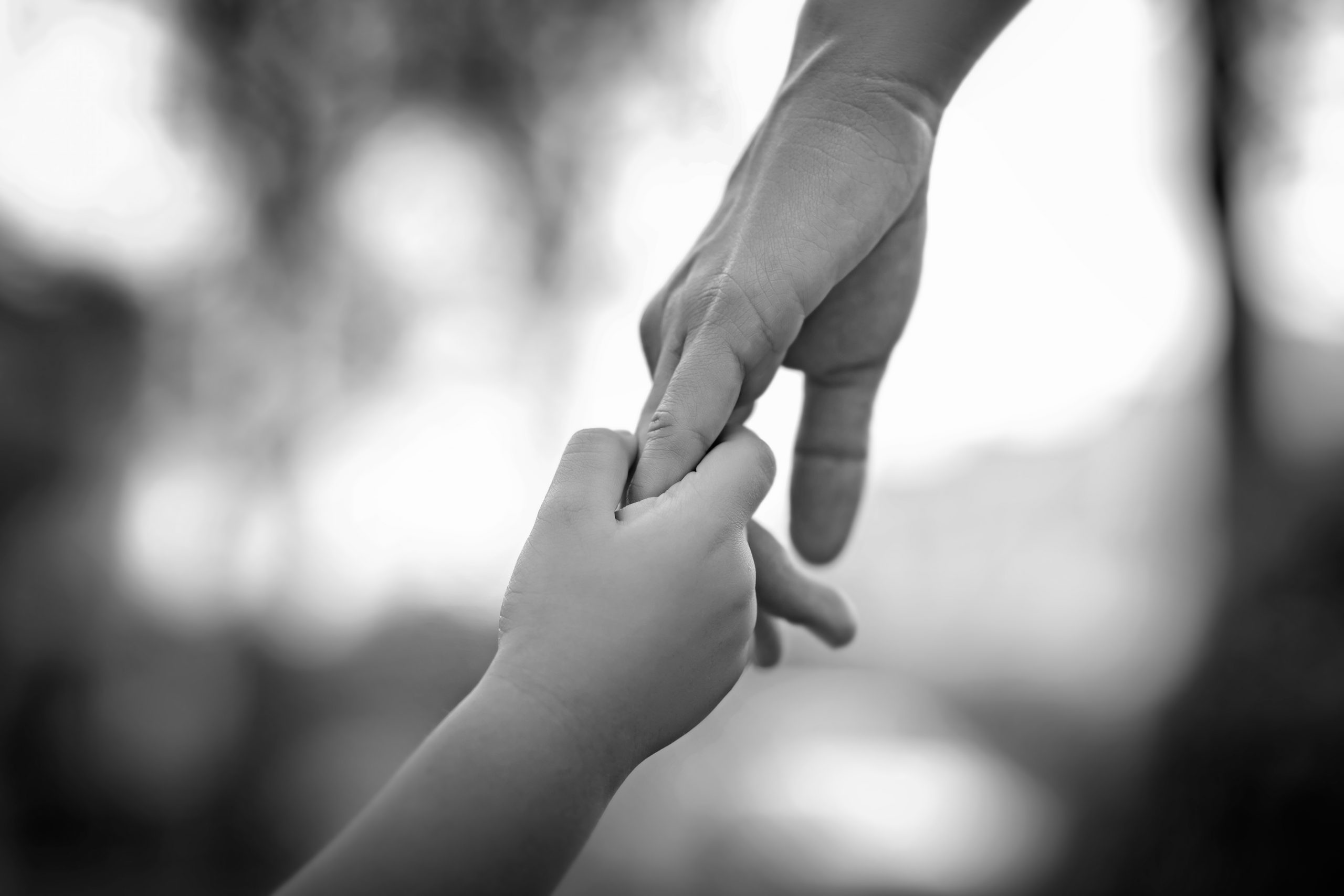“If you don’t stop holding that baby, she’s never going to learn to walk,” a nosey middle-aged man exclaimed in the church lobby for all to hear. My ten-month-old daughter, already an introvert by nature, was wrapped around my body like a koala. For her, the church lobby was a place to be endured. She hated the bustle, the noise, and the constant attention. As a pastor’s family and a transracial adoptive family, we were often the center of attention.
Most people in our community just loved our daughter, and her presence brought joy to them. A handful of people felt obliged to share their parenting advice every time we turned a corner. At ten months old, our daughter wasn’t walking, it’s true. It’s also not outside the norm for typical development. I would have held any of my babies in that crazy after-church mob, but the choice to hold this child was intentional. She needed more. I knew it to my core—she didn’t just want to be held, she needed to be held.
She also spent that first year sleeping in our room (insert gasp here). Yes, she slept in our room, and yes, we are still married. She attended preschool joyfully every day but not before we hugged her, kissed her face, and reminded her exactly what the plan was for pick-up and the backup plan and the backup to the backup plan. This child needed the slow steps toward security that would eventually lead her to independence.
By the way, the man in the lobby was wrong. I kept holding her, and one day she stretched her long legs and took off on her own two feet.
When our children have lost something as vital to their very being as a mom and dad, they need specific parenting strategies to heal from the trauma. They don’t just want more than other kids, and they aren’t manipulating for more time, more space, more attention, more patience. Here are some things they need.
1) Time together. Children learn about trust and security in the months before they are born and the months after. If neglect, abuse, or separation has happened during this time, it will leave lasting insecurity. Parents who wish to create healthy attachment will have to spend extra time building trust. Our kids may need us to sit with them while they fall asleep. They may need us to eat lunch with them during their school day, even in high school. They may need us to volunteer to chaperone on a field trip or just stop by the school to drop off a lunch box. They need us to intentionally set aside time to be completely dialed in to their life. We will talk about balance in a little bit. We can’t spend all our time with one child, but our children do need a lot of time.
2. Patience. Our kids need extra patience. They have experienced something that we were not a part of and that most of us did not experience firsthand. Our children will work through their trauma in different ways at different times. If your child is behaving poorly, there may be a deeper reason for what’s going on. They may not be able to identify what has caused the behavior or their reaction to the trigger. We need to show extra patience. We may appear to be allowing inappropriate behavior, but of course, that is not the case.One of our sons could not attend the worship time during church. He screamed and covered his ears, his body writhing on the floor. It was embarrassing and frustrating. We left church each Sunday in a bustle of humiliation. Then we realized that he is extrasensitive to light and sound. We got him a pair of headphones to wear during church, and we chose not to enter the worship area until the music portion was done. Some people thought we were babying him. Exactly the opposite is true.Once we were patient enough to get past the tantrum, we were able to see that the behavior was about his discomfort. By helping him find the tools to succeed, he was able to attend church and other places like the movie theater and a hockey game. He wasn’t being a brat—he was expressing a need. Being patient enough to get to the bottom of the behavior wasn’t enabling him, it was empowering him. By empowering him to express his feeling and meet his need, we built our own attachment with him. His trust grew when he realized that we were there to help no harm.
3. Guidance. We give our children a gift when we teach them to say “I feel.” Our children need an outlet to work through their trauma. As they grow in their attachment to us, they can heal from past hurts. Our children will need attachment, trust, and security as they grow into adults. Because these things were disrupted, we will have to go back and reteach what should have come naturally. Teaching kids the how to feel is vital to building attachment. When a child is a newborn, parents meet their every need. Through trial and error, parents learn to understand the child’s language. When a child is adopted at an older age, Mom and Dad are not in sync with that early unspoken language. Parents must guide their children toward mutually understood language.
4. Only a few caregivers. No, you may not hold my baby. I’m aware that everyone wants to hold the baby. I get it, I really do. I want to hold all the babies too, but when a family is working on building attachment, all interactions with others must be intentional. Build a close support system around you but remember that not every person is a part of that system. A front carrier is useful for keeping extra hands off infants. We found that having our infants close to us built our attachment and prevented extra attention, which our children didn’t need at that time. Older children could hold a hand, ride in a stroller, or go fewer places with you.Find a babysitter who will understand the importance of consistency in attachment. We know that sometimes sitters, teachers, bus drivers, and friends will change. That’s okay—it’s part of life—but to the best of our ability we try to keep our circle small. This is at least as important with foster kids as it is with adopted kids. Foster children already feel that their world may change at any moment, so do your best to keep the world around your family predictable and small.
5. Continued education for the caregiver. It feels a bit weird to include this in a list that is technically about what children need the most. But, education for us benefits our children. When we make continuing education and training that betters us as caregivers, a top priority, we give our children a gift, because we become better parents. Visit our University to check out some of our training webinars to help with this.
6. Connection to fellow parents. Also an odd one to include in a post like this. But support is crucial. Continuing education and training cannot stand alone. Another great gift we give our children (even if they don’t acknowledge it…and possibly never will) is connection with fellow parents who can sharpen us and point us in healthy directions. When we find (and use) an outlet like this, we equally become better parents. Education and connection must go hand-in-hand!
7. Modeling. Talk about trust and attachment with your children. Model healthy attachments with people in your own life. Create healthy relationships around yourself, and be open with your child about your choices. “I’m friends with Miss Nicole and Miss Megan because they are honest, trustworthy, and kind.” Modeling healthy attachment allows your child to see the benefit to bonding.
8. Strengthening, not enabling. Others may look into our lives from the outside and feel that in our effort to help our children heal, we are actually spoiling them. Our compassion can lead to enabling, so it’s important to ask yourself often, “Am I strengthening or enabling our child?” Our son loves to sleep in our bed. If he could, he would happily stay there all night with one foot in my face and an elbow in my husband’s back. This would not be healthy for any of us. We want him to feel safe and secure in his own room. We want him to feel independent at bedtime, however there are some steps we have decided to take to help him build that confidence. We allow him to start out in our bed when he is feeling extra anxious, and then we move him to his bed when it’s time for us to sleep. This allows him to feel secure without inadvertently teaching him that he cannot sleep on his own. If he is afraid at night, we are always willing to hug him, pray with him, and tuck him back in. We may sit beside his bed for a little bit, but we do not stay there all night or move him back to our bed. This is intentional. We want our son to know we are always here and will always do our best to keep him safe. We want him to also learn that he is safe in his room. He is brave and strong and he can stay in his room by himself.
9. Strengthening through balance. Strengthening our children is about finding balance. Giving our children the tools to use on their own is not enabling—it is teaching. Our children have coping skills they can use when they are away from us. They can do some things on their own to help with anxiety. They know that we have given them these tools so the time away is not damaging our bond, it is strengthening it.One of our sons hated going to preschool. I wanted to pull him out and just keep him home, but our counselor at the time helped me to see that he was having fun at preschool; he was just having anxiety about separating. We created a ten-step process: stay in the classroom, then move to sitting by the door, then move outside the door, then stay in the building, and so on until I was able to leave him all morning and he could trust I was going to come back.Others thought we were babying him, but they just didn’t understand the amount of trauma our child had from feeling abandoned. Our counselor and our son’s teachers understood that our son had a valid reason for needing our presence more than other students. They also understood that it was vital for our son to eventually attend school on his own. By working together, we were all able to help him create a new sense of confidence.
10. Strengthening, not rescuing. Strengthening our children is not rescuing. When our children are struggling, it is so difficult to not reach in and rescue them from the bad test grade, the difficult friendship, or some legal trouble. Strengthening our children means we stand by their side while they go through the tough thing. We do not rescue, but we do stand strong.A child who has lost their first family may need more reassurance that we are still here and we still love them. We may say something like, “I know it was embarrassing for you to have to miss recess today for fighting. I know you are strong enough to take the consequence. I want you to know that I love you very much and nothing will ever change that.” Our kids don’t need to be rescued, but they may need to be reassured.
11. Help distinguishing behavior from emotion. “I know you are feeling…but you may not…” This is a sentence we say often in our home. Outsiders may hear this conversation and make a judgment about what we should do. “Well, I would just wash his mouth out with soap if he ever talked to me that way!” Okay, okay. I know that our child’s reaction to things is sometimes over the top. I know that our child’s dysregulation is uncomfortable and just looks like a tantrum, but stick with me here. By addressing the reason for our child’s behavior, I can help our child to cope in a more acceptable way in the future. “I know you are feeling frustrated, but you may not punch. What can we do instead?” When we separate our child’s emotion from their behavior, we give them a chance to address the feeling in a way that will be productive, not destructive.
BONUS: Structure, consistency, and follow-through. Why do we always leave the neighborhood cookout at 8:00 on the dot? Because we have to. I parent differently because our child is learning to trust. Our child doesn’t do well when things change, and he or she needs to follow the same structure every day. If I maintain consistency, our child can learn to trust, and one day we may be able to stay later at the party. We may be able to skip bath time or go to bed without brushing teeth. But for now, I am teaching the trust through consistency that was disrupted for our child in his or her early life.
BONUS: Yes or no but not maybe. My mom and dad always said maybe. They didn’t want to promise something and not follow through. This made sense to me as a child. If I asked for ice-cream after dinner they said, “I don’t know…maybe. We’ll see if you eat a healthy dinner and finish your chores.” This was fun for me. It was always a kind of challenge, a mystery. We didn’t often get ice cream, but when we did, it was such a treat. The “maybe” felt like a fun adventure.For our children, “maybe” isn’t an adventure. It brings up feelings of uncertainty. Maybe they will have a forever family. Maybe Mom will show up to the visit tonight. Maybe we will have enough food. In our home, we must answer yes or no. We need to be as certain as we can possibly be with our children as they are building trust. If we don’t think ice cream after dinner is a for-sure thing, we will say no first. We may get to go back later and say, “I know we said no to ice cream tonight, but we have a little extra time before bed and you are already done with your chores. What do you think about going out for a special treat tonight?” To the best of our ability, we need to give our children clear answers as we build trust and attachment.
While this list is not exhaustive, these are, what I consider to be, crucial starting points and steps in helping your child work through his or her trauma, and build the foundation for healthy attachment with you, the caregiver.










